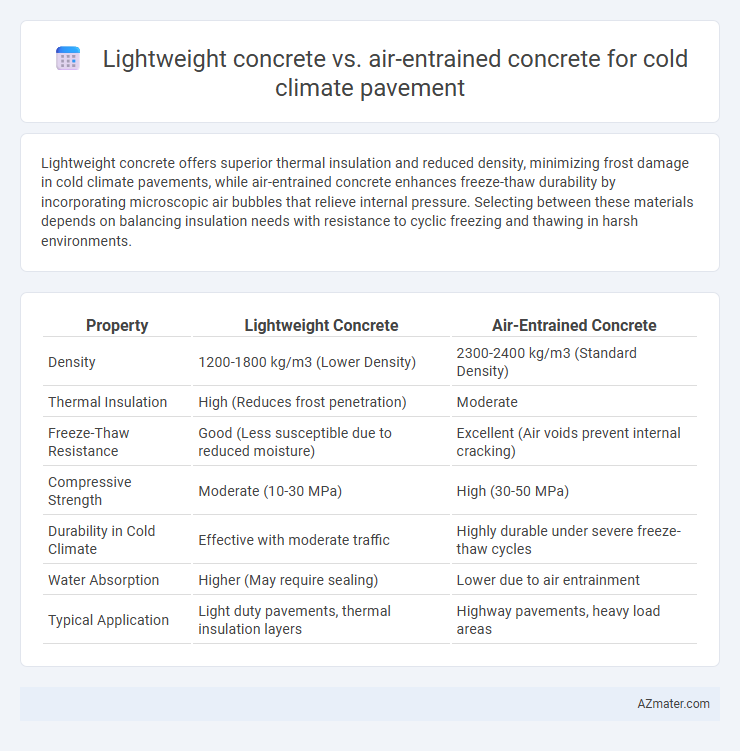Lightweight concrete offers superior thermal insulation and reduced density, minimizing frost damage in cold climate pavements, while air-entrained concrete enhances freeze-thaw durability by incorporating microscopic air bubbles that relieve internal pressure. Selecting between these materials depends on balancing insulation needs with resistance to cyclic freezing and thawing in harsh environments.
Table of Comparison
| Property | Lightweight Concrete | Air-Entrained Concrete |
|---|---|---|
| Density | 1200-1800 kg/m3 (Lower Density) | 2300-2400 kg/m3 (Standard Density) |
| Thermal Insulation | High (Reduces frost penetration) | Moderate |
| Freeze-Thaw Resistance | Good (Less susceptible due to reduced moisture) | Excellent (Air voids prevent internal cracking) |
| Compressive Strength | Moderate (10-30 MPa) | High (30-50 MPa) |
| Durability in Cold Climate | Effective with moderate traffic | Highly durable under severe freeze-thaw cycles |
| Water Absorption | Higher (May require sealing) | Lower due to air entrainment |
| Typical Application | Light duty pavements, thermal insulation layers | Highway pavements, heavy load areas |
Introduction to Concrete Types for Cold Climates
Lightweight concrete and air-entrained concrete are essential for cold climate pavements due to their superior freeze-thaw resistance and enhanced durability. Lightweight concrete offers reduced density and excellent thermal insulation, minimizing frost damage by limiting internal stress. Air-entrained concrete introduces microscopic air bubbles that improve resistance to freeze-thaw cycles and de-icing chemicals, making it a preferred choice for durable infrastructure in cold regions.
Defining Lightweight Concrete
Lightweight concrete is characterized by its reduced density achieved through the use of lightweight aggregates such as expanded shale, clay, or pumice, making it ideal for cold climate pavements due to enhanced insulation properties and reduced thermal conductivity. This concrete type mitigates freeze-thaw damage by minimizing moisture absorption and providing better resistance to thermal cracking compared to conventional mixes. In contrast, air-entrained concrete incorporates microscopic air bubbles to improve freeze-thaw durability, but lightweight concrete offers superior thermal insulation and weight reduction, optimizing pavement performance in frigid environments.
Understanding Air-Entrained Concrete
Air-entrained concrete contains microscopic air bubbles that improve resistance to freeze-thaw cycles, making it essential for pavements in cold climates where freezing and thawing occur frequently. These air voids act as pressure relief chambers, preventing internal cracking and extending pavement durability. In contrast, lightweight concrete offers reduced density but lacks the specialized freeze-thaw protection provided by air-entrainment technology.
Composition Differences: Lightweight vs Air-Entrained
Lightweight concrete for cold climate pavement incorporates lightweight aggregates such as expanded shale, clay, or slate to reduce density while enhancing thermal insulation. Air-entrained concrete contains microscopic air bubbles introduced by air-entraining agents to improve freeze-thaw durability by alleviating internal stresses. The key compositional difference lies in lightweight concrete's use of low-density aggregates versus air-entrained concrete's incorporation of controlled air void systems within standard aggregates.
Thermal Insulation Properties
Lightweight concrete offers superior thermal insulation properties compared to air-entrained concrete, reducing heat loss in cold climate pavements and enhancing freeze-thaw durability. Its cellular structure traps air pockets that minimize thermal conductivity, effectively maintaining pavement temperature above freezing. Air-entrained concrete, while improving freeze-thaw resistance through microscopic air bubbles, provides less thermal insulation, potentially leading to increased energy demands for subgrade protection in cold regions.
Freeze-Thaw Resistance in Pavement Applications
Lightweight concrete offers improved freeze-thaw resistance in cold climate pavement applications due to its lower density and enhanced thermal insulation properties, reducing internal stress from temperature fluctuations. Air-entrained concrete incorporates microscopic air bubbles that provide space for water expansion during freezing, significantly increasing durability and reducing surface scaling and cracking. Both materials enhance pavement longevity, but air-entrained concrete remains the standard choice for optimal freeze-thaw durability in harsh cold environments.
Structural Performance and Load-Bearing Capacity
Lightweight concrete offers reduced density and improved thermal insulation, which minimizes frost damage in cold climate pavements but typically has lower compressive strength compared to conventional mixes. Air-entrained concrete enhances freeze-thaw durability by introducing microscopic air bubbles, significantly improving resistance to cracking and scaling under cyclic freezing and thawing conditions. Structural performance and load-bearing capacity in air-entrained concrete are generally higher due to better matrix integrity, making it more suitable for pavements subjected to heavy traffic loads in cold regions.
Workability and Placement in Cold Conditions
Lightweight concrete offers enhanced workability and reduced density, facilitating easier placement and quicker setting in cold climate pavements due to its insulating properties. Air-entrained concrete improves freeze-thaw resistance by incorporating microscopic air bubbles, which maintain workability but may require careful adjustments in water content and admixtures to ensure proper placement. Both materials demand precise temperature control and curing practices to optimize performance and durability in cold weather pavement applications.
Durability and Longevity in Harsh Environments
Lightweight concrete offers improved thermal insulation and reduced freeze-thaw damage due to its lower density and enhanced pore structure, making it suitable for cold climate pavements. Air-entrained concrete incorporates microscopic air bubbles that increase freeze-thaw resistance by allowing expansion space for water freezing within the concrete matrix, significantly enhancing durability. Both types improve longevity in harsh environments, but air-entrained concrete generally provides superior resistance to scaling and surface deterioration under freeze-thaw cycles in cold climates.
Cost Efficiency and Sustainability Considerations
Lightweight concrete reduces the pavement's overall load leading to lower foundation costs and improved thermal insulation, which enhances cost efficiency in cold climate applications by reducing maintenance and freeze-thaw damage. Air-entrained concrete improves durability through enhanced freeze-thaw resistance, extending pavement lifespan and reducing repair frequency, contributing to long-term sustainability. While lightweight concrete offers energy savings during production due to lower material density, air-entrained mixes optimize resource use by incorporating entrapped air voids that improve durability with minimal material increase, both favoring sustainable infrastructure development.

Infographic: Lightweight concrete vs Air-entrained concrete for Cold climate pavement
 azmater.com
azmater.com